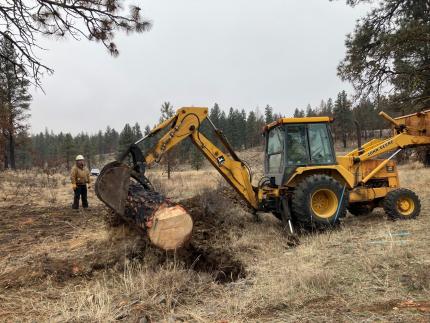Managing Wildlife Populations
District 4 Bobcat Sealing: District 4 Wildlife Conflict Specialist Hand sealed a bobcat for a hunter that harvested the animal in the Blue Mountains.
District 8 Deer Monitoring: District 8 biologists continue to monitor movement and survival of collared deer. Recently many roadside mortalities have occurred. During winter months, wildlife are at an increased risk of vehicle collisions as they are often drawn to salt along the highways and county roads.

Columbia Basin Deer Surveys: District 4 Wildlife Biologist Fidorra worked with biologists across the Columbia Basin. They began to survey mule deer on the wintering grounds for a post-hunt population estimates and age to sex ratios. They will continue surveys by helicopter into December for the Odessa sub-group, while road surveys across the basin are also completed.

Providing Recreation Opportunities
Sunnyside-Snake River Pheasant Release: Sunnyside-Snake River Wildlife Area staff members and Natural Resource Technician Manderbach released pheasants at various sites across the Columbia Basin prior to the Thanksgiving holiday weekend.

Wenas Wildlife Area Sheep Company Road Target Shooting Range Trash Clean Up: Wenas Wildlife Area Lands and Recreational Specialist Frame collected over 1,700 pounds of trash and target shooting material from Sheep Company Road target shooting area as well as the Durr Road shooting area. Items included computers, target shooting material, pumpkins, five-gallon buckets, a plastic mannequin, and plywood.


Providing Conflict Prevention and Education
Rattlesnake Hills Elk: District 4 Wildlife Conflict Specialist Hand monitored elk activity and removed trail cameras for the winter that were deployed on active historic trails leaving the Hanford National Monument.
Kittitas County Conflict: Conflict Specialist Wetzel worked with several hay growers who were having problems with elk in crops. A helicopter was used to move elk from several locations in east Kittitas County.

District 8 Goat Depredation: A Thorp goat producer reported several goats killed in an area where he has seen a cougar in the last few weeks. The cause of the goat deaths was undetermined.

District 8 Deer Fatalities: Several deer were reported injured or killed by vehicles in the Cle Elum area. Several deer were either euthanized or retrieved from roadways and nearby residences. Conflict Specialist Wetzel euthanized a deer that had two broken rear legs due to being struck by a vehicle. He removed it after it crawled into a garage.


Yakima County Conflict: Conflict Specialist Wetzel worked with several hay growers who were having problems with elk in orchards. The elk have been hazed from their orchard areas.
Conserving Natural Landscapes
Bull Pasture Restoration: The Wenas Wildlife Area is restoring approximately 130 acres off Bull Pasture Road into native grass seed. This site has been chemically fallowed for two years to prep the bed prior to seeding and gain a better control of the cheatgrass and bulbous infestation. Natural Resource Technician Trahern and Assistant Manager Taylor continued harrowing and seeding the Bull Pasture area rehab.
Wenas Umtanum Creek Enhancement: Wenas Wildlife Area Manager Hughes, Assistant Manager Taylor, and Natural Resource Technician Stoltenow worked together on installing a log barb and conducted light excavation to reroute a section of Umtanum Creek that consistently flows over the county road bringing additional sediment into the creek.

Hughes received a hydraulic project approval (HPA) last winter to conduct the project. The main purpose was to correct environmental degradation and deflect the flow away from where it captures an existing county road. Habitat Biologist Bartrand was heavily involved in planning the project and overseeing the work conducted. This project will benefit the stream habitat by not taking sediment/gravel off the county road each year. It will also benefit the community who drive over the county road.


Colockum Creek Timber Restoration: Colockum Wildlife Area staff members and Washington State Department of Fish and Wildlife (WDFW) foresters have started burning slash piles left from the Colockum Creek timber restoration project. Over 100 slash piles were created from this 950-acre timber restoration. Colockum Wildlife Area Assistant Manager Hagan spent considerable time logging GPS location and pile volume information so that WDFW foresters could apply for burn permits. After permits were secured, they started lighting piles contingent on daily smoke management approval from the Washington Department of Natural Resources.

Providing Education and Outreach
Oak Creek Wildlife Area Elk Feeding Station: Oak Creek Wildlife Area staff members prepare for upcoming elk feeding tours and large numbers of visitors by posting newly updated bilingual signage. This new signage will provide important information to thousands of people that are anticipated to visit the Oak Creek feeding station during the upcoming winter.



Other
Sunnyside-Snake River Wetland Maintenance: Sunnyside-Snake River Wildlife Area staff members continue to maintain waterways and wetlands throughout the wildlife area. Assistant Manager Ferguson and Natural Resource Technician Manderbach removed debris from the diversion weir box in the Johnson Wetland. Assistant Manager Jahns and Manager Kaelber also removed beaver debris in the Hope Valley Unit to alleviate flooding on neighboring private property. Routine maintenance and debris removal is required to regulate flow and maintain water levels in all waterways and wetlands throughout the fall and winter.


Wenas Wildlife Area Maintenance: Wenas Wildlife Area Assistant Manager Taylor and Natural Resource Technician Stoltenow added gravel to high traffic and muddy portions of the parking lot at both the main Wenas office and the Mellotte office. They used a dump truck to haul the gravel in, and they used a skidsteer/backhoe to spread and compact the gravel into place.